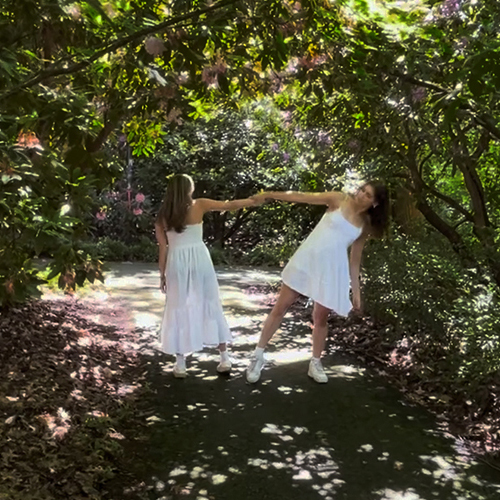In the film 27 Dresses, a perpetual bridesmaid fills her closet with dozens of bridesmaid dresses she’s worn at weddings. But that’s nothing compared to the 58 wedding dresses the School of Drama (SoD) recently acquired for its costume shop, which supports School of Drama productions.
The dresses, valued at more than $40,000, were a donation from La Belle Elaine’s, a bridal shop where SoD graduate student Valeka J. Holt bought her own wedding gown. The gift was the result of a friendship that developed between Holt and Hanya Gore, the shop’s owner.

“Hanya knew I was an acting student at the UW, so we talked about theatre a lot,” says Holt. “One day she emailed me that the store had all these wedding dresses—last year’s dresses—and asked if I thought the School of Drama could use them. We’re talking charmeuse dresses, sequined dresses. Absolutely beautiful gowns.”
Josie Gardner, supervisor of SoD’s costume shop, told Holt she’d welcome the donation, so Holt and classmate Sarah Loveland drove to La Belle Elaine’s to pick up the gowns. “We stuffed them into Sarah’s Camry, with dresses out the wazzu,” recalls Holt with a laugh. “It was like a scene from Sex in the City.”
The dresses are now part of the costume shop’s expansive collection, which includes everything from Greek and Roman togas to Renaissance gowns to coconut bras. (No, they don't rent to the public.) About a third of the items are donated.
The wedding gowns may have been the year’s most unexpected donation, but a few others stand out as well. Gardner was particularly tickled when a 98-year-old alumna donated boxes of clothing that included nine top hats, authentic crotchless bloomers from the early 20th century, and delicate dresses. “Look at the buttons on this one,” enthuses Gardner, holding up a woman’s blouse that dates back at least a century. “This is a real vintage piece, not a costume.”

Gardner’s excitement over buttons hints at her devotion to the collection. Having worked in the costume shop for 20 years—the shop dates back to 1935—she knows the story behind most of the items in its seven storage rooms, which are packed floor to ceiling with clothing and accessories. And she has developed systems to keep the unwieldy collection organized.
“Everything is stored by the decade it represents and then according to color, because color is an obvious place for a designer to start,” explains Gardner. “Each item is inventoried and catalogued with its size and description so things get put back in the right place and can be found again.”

In addition to donated items, the collection includes many pieces designed by students studying costume design. (The School of Drama offers an MFA in costume design as well as costume classes for undergraduates in Theatre Studies.) In fact, says Gardner, the School follows the rule of thirds when planning for its productions: a third of the costumes come from the costume shop’s collection, a third are designed and built in-house, and a third are borrowed from other institutions or purchased.
“Ebay is great for specific needs, like when we were looking for high-heeled laced-up tennis shoes from the 1980s,” says Gardner. (She’s not kidding.) As for borrowing, “we have a reciprocal agreement with many other theatres in Seattle, including Seattle Rep, Seattle Opera, ACT, and Intiman. They borrow from us; we borrow from them. They love to borrow from us because they know the stuff is high quality.”
That quality extends to the pieces designed by students. “For every production, some things get built,” says Gardner. “Our students need the experience. We have a full-time tailor and full-time woman’s cutter (pattern maker) on staff to assist.” Donated items—even some that are not in condition for stage use—can be invaluable as teaching aids for those students. Some of the recently acquired antique dresses, for example, allow students to see how darts were placed in the early 1900s, which is not how they’re done today.
With new and donated costumes continually being added to the collection, deaccessioning is essential. Gardner sifts through the collection each year to cull items that are in poor condition or no longer needed. Some are given to other groups, while others are repurposed. “If I haven’t used an item in six years, I’ll usually allow students to cut it up and make it into something else,” says Gardner. “Each item is considered individually.”
Gardner admits that certain items would be difficult to give away, knowing the story behind them. There are the stunning black dresses donated by a widower whose wife, a musician, had worn them for her performances. There are the World War II uniforms donated by veterans or their spouses. And there’s the collection of 30 hats that were donated by a woman battling cancer.
“That donor was the first fashion editor of The Seattle Times,” recalls Gardner. “She knew she was dying, and she wanted us to have her hat collection. Each hat had a story, including the hat she wore for her first job interview.”
Gardner believes that stories like these are what make the collection so special. “I love the stories of people’s clothes and why they kept certain things all these years,” she explains. “When they donate them, we become the keeper of the stories. Part of my job, I think, is to really listen to those stories and honor them.”
Josie Gardner has created a Twitter feed, UWFrocknFinery, to share interesting tidbits about the collection. You can find it at twitter.com/UWFrocknFinery. For more about the School of Drama costume shop or the School’s MFA in costume design, visit drama.washington.edu.
More Stories

Dancing Across Campus
For the dance course "Activating Space," students danced in public spaces across the University of Washington's Seattle campus this spring.

Celebrating Contemporary Indigenous Music
Markus Teuton, a musician and citizen of Cherokee Nation, explores contemporary Indigenous music through his academic work and as host of “Indigenous Jazz,” a radio show.

All the World's a Stage — and a Game
Students in DRAMA 480 learn how techniques used in game design can be adapted for interactive theater productions.